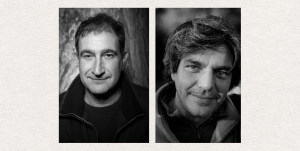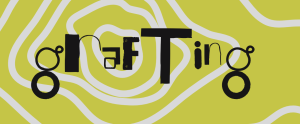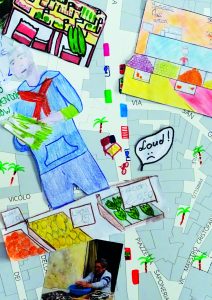(In progress report)

Between November 11th and 25th we have run the “Who Owns Kreuzberg” workshop at the FXHB Museum. This Urban Reconnaissance laboratory involved a group of activists and researchers in “mapping creativity and resistance” in Kreuzberg, with the aim to provide an insight into the complexities of urban transformations in the city and to co-create tools for supporting the struggle for the right to the city. Additional task was to test a format of workshop to be repeated next in Mexico City and Rio de Janeiro in the frame of the CoCreation project, with the final objective to collect ideas and material for an exhibition. The workshop took place during three afternoon-meetings and included two short walks in the neighbourhood. It was attended by a dozen of people with different backgrounds and level of knowledge of the area.
First we asked ourselves if another mapping was needed in Kreuzberg: many maps have been already produced by activists, researchers and journalists in this area and in Berlin (see the work of Correctiv for Tagesspiel, Wem Gehört Keuzberg, Bizim Kiez’s Karte der Verdrängung). Then we said, yes, our project makes sense for at last two reasons: the first is the specific focus that we are bringing on creativity – creative people, practices, industries – as a factor affecting urban development and the right the city. That is, we question creativity as a double edged tool for both developing urban spaces and supporting social struggles.The identity of Kreuzberg has been strongly determined and effected by the inflow of artists, media creatives and the imaginative use of space and place. However, the mask of creativity and creative innovation has also been cunningly employed to pervert the organic development of the city towards increasing and extracting financial value for private companies.
The second reason is because while most of the existing maps are essentially geographical databases, collections of pure information in some standardised format, we are interested in stories, in using mapping as a storytelling practice. We want to experiment a “narrative map”, a collection of different examples that employ multiple languages and formats to represent the variety of issues at stake. Ultimately, to use creative mapping as a means for sharing knowledge and empower communities.
In our workshop ‘Who Owns Kreuzberg?’ we propose to map key stories illustrating how creativity has been used on opposing sides of the gentrification struggle, both to develop the value of Kreuzberg as a common asset for its inhabitants and as a financial asset for private investors, forming in the process a controversial and often fascinating identity for the neighbourhood and the rest of the city surrounding it. The resulting map of these narratives and our journey through them will be contributed back to the community as a resource for research and reflection, as well as forming a key contribution to the collective exhibition we are planning for 2021.

Day One
The workshop started with a visit a the permanent collection of the Museum, a museographic project that was originally community driven, created to document the history of urban development and social struggles of Kreuzberg, and the peculiar cultural milieux known “Berliner Mischung”.
From there we moved to listen to some exemplar stories of urban development, displacement and resistance: Hendrik presented the Kamil Mode case, Maria the Lause bleibt campaign and Lorenzo the story of the Cuvry Brache. We continued then to upload more possible stories on a Trello board, the online tool we adopted to archive and share the collected information. At the end of the session, each participant was asked to identify one story to work on, and to investigate it by the next meeting.

The team continued to coordinate and exchange ideas and info during the week, including the participation to the Laterne Demo “Kiezdrache gegen Verdrängung ”
organized by Bizim Kiez.
Day Two.
The next session was introduced by a walk, during which we visited some of the places selected and the participants reported about findings related to their cases. We visited among others the Kotti and Co. Gecekondo, the Moviemento Kino, Google campus, Meuterei, Lause, but also noted along the path several related storie, spaces, campaigns. Walking is a generative process…

Back at the Museum, we had a round to present the final choice of each participant on a story to tell for their personal contribution to the lab, and we discussed about formats ad languages to adopt for their final redaction. We left opent every option on how eventually to present each story – written piece, interview, video, performance, drawings and graphics – but we asked that each story should try to answer at least a basic common set of questions:
- Who owns the property? When, from whom was acquired?
- Who developed strategies from development and marketing of the projects?
- Who opposes the initiative?
- what is the main reason of opposition or critique?
- how is creativity employed to develop and market spatial processes?
- how is creativity employed to resist or promote alternative visions?
- what is the role and position of the public (local / state institutions) in the conflict / negotiation?
Finally, we closed the day with a little mapping exercise: using sticky notes with colours associated to four general phenomenologies – Emotions, memories, contradictions and – attractions – we asked the participants to fill a map of Kreuzberg with hints of their personal geographies and connections with the neighbourhood.

Day three
Also in this case we started the day with a short tour. This time we visited Rachhaus / Bethanien, and then we moved towards Moritzplttz with the stories of Pandion and Prinzessinnengarten.
Back in the Museum, we started with a peer to peer session in which the participants have been revising in tandems each specific question related to each story. The following plenary sesion has discussed the final choice of the stories and the state of art in their scripting process. We understood that there was still much work to get to deliver each story in a form sufficient to be published and disseminated, but the participants agreed on the interest in continuing the laboratory towards new appointments.
Next steps
- The production of a narrative map, that uses the abstracts and keywords identified during the lab to illustrate the emotional and political landscape of Kreuzberg as emerges from its struggles and visions for transformation.
- A walk to be realised sometimes around February to present the stories collected in form of a journey (Urban Safari).
- A final event presenting the outcomes of the lab and the plans for the final exhibition in spring 2020.
(report in progress)


